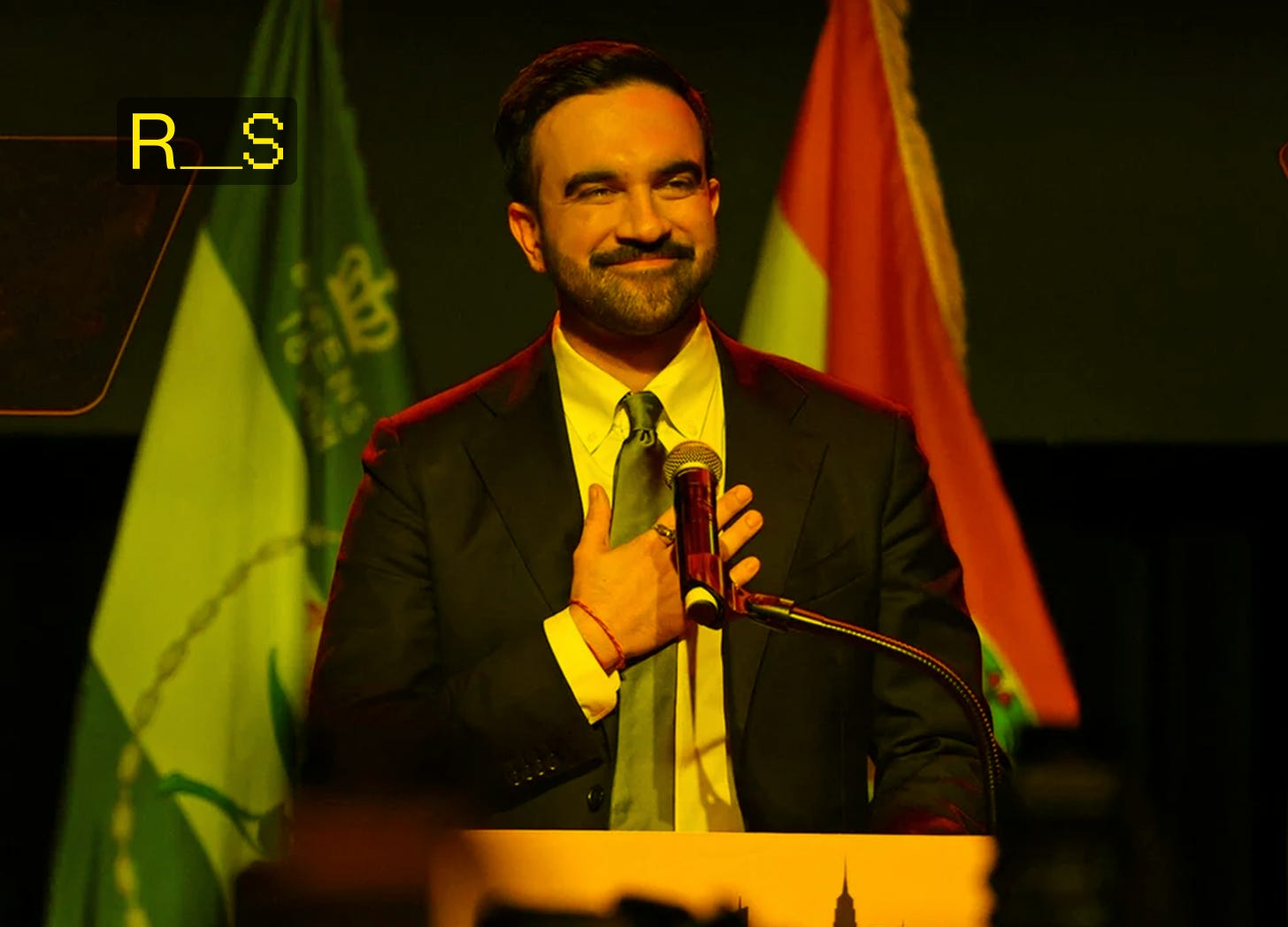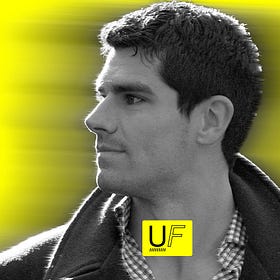What Zohran Mamdani's Election Means—& The Work He Must Now Do
How the NYC Mayor-Elect succeeds in 2026, based on the power he has and the negotiations he can undertake.
First of all: hell yes.
This is the first time I’ve felt joy about anything in American politics for a long time. Let’s quickly talk about what this means.
ICYMI 👉 I’m hosting what’s sure to be a lively Live today with Michael Garfield at 12pm ET/9am PT: Rewilding Reality in the Age of Deepfakes, AI, & Epistemic Collapse.
Hope to see you there! Come with comments and questions!
What Mamdani’s Win Means for NYC & America
There is so much to be excited about that it would require a long-form report to capture it all: the focus on practical change based on actual voter needs, the loud message to the Democratic Party that there is a broad coalition (including the fabled youth vote) that will win elections if they produce appealing candidates, and the rejection of xenophobia—to highlight just a sample among so much more.
For now, as I continue to process my thoughts (I’ll probably update this piece in the days and weeks to come!), what I want to foreground is that the weaponization of “socialist” as a slur doesn’t work anymore. Class consciousness is here and it’s surging.
This is seismic.
What’s been amply clear for years now is that the Democratic party lost the plot, seeking almost exclusively to reinforce status quo neoliberalism, foremost in currying favor with the center right and placating the ultra-wealthy. In a nutshell: they haven’t been listening to their voters. Wealth inequality is at record levels, and it’s sparking what it historically tends to spark: rage. Left unchecked, that rage can spark collapse:
Goliath's Curse: How & Why Societies Collapse, & What We Can Do About It - Luke Kemp | #54
ICYMI 👉 I’m going Live on Substack with Megan Mayhew-Bergman today at 12pm EDT/9am EDT for “How to Tell Strategic Stories that Clarify Climate Crisis.” Come with questions!
The stock market may be booming on the back of AI investment (which looks more and more like a bubble every day), but jobs are decreasing and inflation is continuing to rise (albeit at slightly less catastrophic levels than a few years ago), which means that everyday people are taking the hit. It’s not abstract for us, it’s palpable. Indeed: “It’s the economy, stupid.”
Looking at the data, it’s pretty simple: the happiest countries are social democracies. Fighting wealth inequality means regulation that disincentives and outright prevents unchecked accumulation. If Mamdani can pull off even a fraction of what he claims are his goals, we’ll be headed squarely in that direction—in the beating heart of the capitalist enterprise: the wealthiest city in the wealthiest country in the world.
To be clear: how this would manifest at scale, outside the context of New York City, can and should vary widely. Different cities and states have different priorities, but as long as the aim is redistributing wealth back toward a healthy middle class, people will be happy. That fabled “great” America that MAGAs misguidedly want to return to, in fact, is the fruit of New Deal-era economics, which embodied the ideals of democratic socialism.
Concurrent with the rise of Donald Trump and MAGA, there’s been increasing talk on the left of the need to take a page from the Republican playbook and focus on local politics. This effort to relocalize the left just found its poster boy: Mamdani’s win is a clear signal that this type of grassroots, common-sense platform works. If Democrats want to win, they need to wake up to this reality, and fast.
But standing in the way of that signal becoming reality are some uphill battles—some at a gentle incline, others at a slant approaching vertical. Let’s take a look at this from a feasibility perspective—after all, Mamdani may be a democratic socialist, but there are powerful interests that are champing at the bit to see him fail.
Mamdani’s Campaign Platform
Mamdani’s platform spans housing, climate, transit, labor, equity and city-financing. To call it ambitious is an understatement. And yet if he succeeds, it will make life for millions of New Yorkers unimaginably better—and it will signal to the rest of the country that a democratic socialist platform is the way.
Before we get to analysis, let’s quickly recap some of his prominent proposals:
Freeze rents on rent-stabilized apartments.
Build massive amounts of 100% affordable housing.
Make city buses free and faster.
Launch universal no-cost childcare (infants through pre-K).
Pilot city-owned grocery stores (one per borough).
Establish a “Department of Community Safety,” shifting crisis response away from traditional policing.
Raise the minimum wage to $30 by 2030.
“Tax the 1% and corporations” to fund these expansions.
Retrofit and “green” the school infrastructure and turn schools into resilience hubs.
Crack down on predatory landlords and deed-theft, support labor protections, libraries and equity-measures.
Evaluating Feasibility
Some of these ideals plug into relatively direct mayoral levers; others hinge on external institutions (state government, boards, agencies) or require a sea-change in capacity and finance.
Levers Mamdani can pull
City departments (housing enforcement, data/collections, inspections) can be mobilized to crack down on predatory landlords and seize unpaid fines.
Capital-investment programs like school retrofits can be re-prioritized under the mayor via the Department of Education/School Construction Authority and paired with state/federal grants.
Launching pilots for city-owned stores: feasible via the NYC Economic Development Corporation (or a newly created public operator).
Labor protections and local policy/regulation on delivery workers, gig economy, municipal contractors are typically urban regulatory levers.
Library funding, LGBTQIA+ protections, equity-programming: largely within city control via budgetary and executive orders.
Levers Mamdani doesn’t fully control
Taxation authority (raising taxes on the 1% or corporations) sits largely at the state level—city can lobby, but will need support from the state.
Minimum wage setting in NYC: State pre-emption still looms, so changing that would require state-level change first.
The fare-free buses are partially city-controlled (lanes, signal priority) but fare policy and the system budget depend heavily on a state entity: the Metropolitan Transportation Authority.
Rent freezes via the Rent Guidelines Board: while the mayor appoints members, the Board votes independently.
Massive affordable-housing goals involve state tax credits, public-private financing, large-scale site acquisition—all of which involve cooperation from outside entities and the state.
Ranking Feasibility from Highest to Lowest
High
Crack down on bad landlords/collect unpaid fines
Green Schools/school retrofits & resilience hubs
Pilot city-owned grocery stores
Medium
Freeze rents on stabilized apartments
Fare-free buses & bus speed-up
Universal no-cost childcare (infant–pre-K)
Low
Build 200k 100% affordable homes (10-year target)
Department of Community Safety (full paradigm shift—remember, the NYC PBA is powerful)
Raise NYC minimum wage to $30 by 2030
Tax the 1% & corporations to pay for agenda
Scenario: The First 100-Days (& Beyond)
Given the resource and institutional constraints, what follows is a realistic sequence of deployment from day 0 of a new administration, with emphasis on high-feasibility actions first.
Note: while these are to the best of my knowledge within Mamdani’s power, I’m not claiming that these are the best ways he could achieve his campaign goals. Rather, I’m trying to sketch samples of how it could work based on the research I’ve done. Part of that is building out the argument for various policies by implementing case studies and mayoral products through which he can then push for continued action.
I’ll update this as I learn more—if you think I’ve gotten something wrong or missed something critical, please tell me in the comments!
Days 0-30
Appoint/enforce a new inspector-general for housing enforcement and direct the agencies (HPD, DOB) to publish a “landlord violation inventory and unpaid fines” dashboard.
Launch an executive order directing all city capital investment (DOE/SCA, parks, DOT) to prioritize green-retrofits and resilience-hub conversion, i.e., an EO titled something like: “Green Schools & Community Resilience.”
Announce a pilot for public-house-grocery stores: identify one site in one borough, issue an RFP within 60 days, with goal to open within 18 months.
Days 30-100
Move to expand bus-lane/signal priority program city-wide, as leverage to later push for fare elimination. Publish baseline bus performance metrics.
Begin contracting for childcare facility expansions and recruit workforce; launch a “universal childcare task-force” to model cost/schedule.
Conduct an inter-agency review of the staffing, jurisdiction and scope of crisis response—draft charter for Department of Community Safety and begin stakeholder negotiations (police unions, social services, housing/shelter outcomes).
Submit to the City Council (and Budget Office) a “tax the rich/corporate” revenue-opportunity brief — build case and constituency for state-legislation in Albany.
Year 1
Implement full scale landlord‐violation enforcement drive.
Open the first city‐owned grocery pilot, evaluate and plan scaling.
Release capital plan update for 5-year incremental affordable housing build (e.g., 50,000 units) and begin zoning/ULURP reforms to unlock public sites.
Negotiate with Albany and MTA for bus-fare pilot; if unsuccessful, accelerate the bus-speed improvements and communicate phased path to fare-free.
Roll out the green-schools program: retrofit first tranche of schools, publish energy/resilience metrics.
Why This Matters
From a futures/foresight lens, what’s at stake here is not just immediate policy: it’s the structural trajectory of the city (and by proxy, the nation at large). Will we see incremental interventions (the high-feasibility items) or full regime shifts (the low-feasibility ones) in one term? I adore Mamdani’s bold, unapologetic language and positions, but he can’t do this alone. Institutional alignment, capacity, revenue, timing all matter—and his success in these collaborations become a blueprint for other cities and states.
The high-feasibility items above point to the path of least resistance—basically getting some clear wins on the board using existing institutions, capital budgets, city departments. The low-feasibility ones are the truly systems-changing bets, and as such de facto require state cooperation, large scale revenue shifts or paradigm overhaul.
Drawing on my polycritical foresight methodology, here’s what I think we should all be closely tracking starting in January 2026:
Lead-indicators: e.g., published dashboard on landlord violations; bus-speed metrics; first green-school retrofit. These will be early markers of whether capacity is mobilized.
Weak-signals: e.g., New York state offering preliminary talks on city tax autonomy; pilot childcare sites opening; early grocery-store RFP responses.
Black-swans: Labor strike delays, state budget crises, federal funding withdrawal (plus other gnarlier interventions by the Trump administration), major natural disaster(s) altering priorities.
If we’re pushing for “systems transformation” vs. incremental reform, the real question is less about what Mamdani can accomplish in one or (inshallah) two terms and more about what foundations he can establish in order to hand the baton off to future policymakers across the city and state. How many of the low-feasibility items can be lined up as viable trajectories even if not fully implemented? Can the mayor set in motion policy regime-shifts that go beyond the first term?
And let’s be clear: just doing this would be a monumental feat, which would bring material benefits to millions of New Yorkers, and hopefully inspire similar activities across the nation. If we believe in this platform, we have to be willing to applaud the effort alone, as well as the small wins along the way. As they say, it’s a marathon, not a sprint.
In the meantime, today is a great day. I hope you celebrate it as such.





The landlord violatons dashboard within the first 30 days is a brilliant move. Publishing this data publicly will create immediate accountability pressure and give tenant advocacy groups the transparency they need to organize around specific properties and owners.